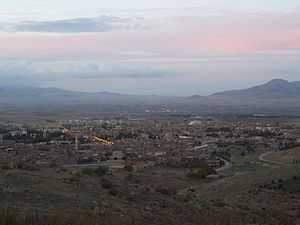Lamasba

Lamasba was a Roman colonia in Romano-berber Africa. It is the actual Merouana in Algeria.
History
Lamasba (called even Lambafundi[1]) was a city of Roman Numidia about a hundred kilometers south of Cirta and near Lambesis. The town was probably an important center in the plain of Bellezma and was on a road junction. The urban development of the city is unclear, but it is possible that she had a part of its growth due to the installation of Roman soldiers, as was the case in other cities of Numidia as nearby Diana Veteranorum.
Lamasba, which was called Respublica Antoniniana was in the middle of an area with irrigation created by the roman veterans who settled there [2] and probably enjoyed municipal status under emperor Caracalla. At four kms there was the vicus (village) "Verecunda", populated mainly by romanised berners. The city's founding date back to the era of the Romans in 127 AD. It was a fortress which was damaged by the Vandals. It was rebuilt by the Byzantines and become a military area for Byzantines military retirees.
The city was a Christian see since the third century, with a bishop from 256 AD at least. In 411 AD, at the "Conference of Carthage", Lamasba was represented by a Donatist bishop and by a Catholic bishop.
The site is especially renowned because of the discovery of a major epigraphic text, an irrigation settlement dated from the reign of emperor Elagabalus.[3]
After the Arab conquest around 695 AD when was destroyed the local fortification, the site remained depopulated for centuries. Only in 1909 the French colonists recreated there a city that they named Corneille (and that now is called Merouana).
Notes
Bibliography
- B.D. Shaw. Lamasba:an ancient irrigation community. Antiquités Africaines, 18, 1982 (p. 61-103)
- C. Meuret. Le règlement de Lamasba: des tables de conversion appliquées à l'irrigation Antiquités Africaines, 32, 1996 (p. 87-112)
See also
- Roman 'Coloniae' in Berber Africa
- Romano-Berber states
- Christian Berbers
- Caesarea
- Cirta
- Lambaesis
- Chullu
- Milevum
%2C_Algeria_04966r.jpg)